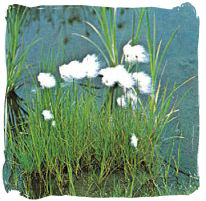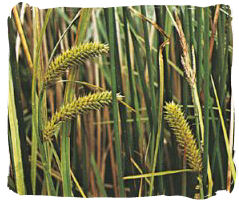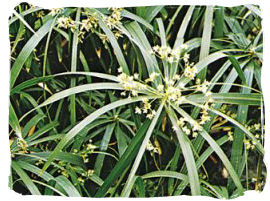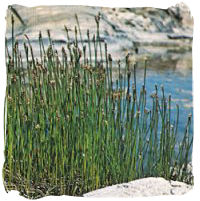Health & Medicine
&nsbp;
Healing Plants Found on Gor
Medicine on Gor is not heavily discussed, however, based on the following excerpt, it would seem that at least in the cities, the practice of medicine was advanced, though how advanced, it is not ever truly defined. Please note the words "relatively advanced." More than likely, the medical technology of Gor would rival that of ancient Rome, as depicted on the main Medical page, based upon certain implements mentioned briefly within the books themselves.
"There is at least one area, however," said my father, "in which the Priest-Kings do take a most active interest in this world, and that is the area of technology. They limit, selectively, the technology available to us, the Men Below the Mountains. For example, incredibly enough, weapon technology is controlled to the point where the most powerful devices of war are the crossbow and lance. Further, there is no mechanized transportation or communication equipment or detection devices such as the radar and sonar equipment so much in evidence in the military establishments of your world.
"On the other hand," he said, "you will learn that in lighting, shelter, agricultural techniques, and medicine, for example, the Mortals, or Men Below the Mountains, are relatively advanced." — Tarnsman of Gor, page 31
No doubt you're tired of seeing the following, but I feel I must reiterate despite that I know even said once has earned me enemies…
All too often seen in virtual chat Gor, are healers that bring contemporary Earth healing methods into role play. Well-baby care, prenatal care, MRIs, and such are all 21st century earth culture, and not Gorean. Too, depending upon the culture involved, medical practice is likely to be quite simplistic. For example, the Wagon Peoples hold a great distrust for things of the city as well as the written word. The red savages were distrustful of anything to do with the white man. It's quite unreasonable to expect a full-fledge hospital burning bright energy bulbs with bustling nurses and tubes and tubes of IVs and nuclear machines blinking off and on in the jungles or the plains of Turia or the Tahari. Not that you'd even see something akin to that in the cities!
But I have seen nuclear medicine used in chatrooms. Considering that the Priest-Kings were considered with anything that could lead to potential weapon risks, nuclear technology would never be allowed, even in medicine.
To see such practices in a roleplay room is rather an indulgence by those portraying such; perhaps because they wish not to take the time to learn a more simplistic medical practice. Of course, most roleplayers portraying a healer or physician — is not either in real life, and instead practice a Marcus Welby, MD sort of medical practice in roleplay rooms. It's obnoxiously annoying, especially for those who truly want realism in roleplay.
Too, we see a lot of healing remedies that are of earth nature (i.e., willow-bark, dandelion, agrimony, etc.) which are doubtful would be found on Gor. What we can probably determine is the variety of curatives available based on specific vegetation found on Gor.
More often than not, I see someone do something with regards to medicine on Gor, or create medical manuals, that have no backing in the books. But wait. There are excuses. Reasons, sorry. There are reasons why there is willow-bark on Gor; and agrimony. And nuclear medicine. And well-baby books. The reasoning that I've seen given often is — "When I went to Earth on a Voyage of Acquisition, I brought back what I needed." Or, "I visited with a merchant who had been a part of a Voyage of Acquisition and he brought back things necessary." Or, "I brought the items with me when I was captured on Earth." And the list goes on …
Mind you, out of the mouths often of those who cry out for more "realism" in roleplaying. In fact, here is an actual verbatim post that was made October 2005 in a room in Alter Realm, provided to me by a friend (names have been removed for obvious reasons):
(19:47:19 )
[PIC]
name deleted
title deleted
near the Warmth of the Fire
says toname deleted: and I just returned from urth so I am well stocked on supplies
WHOA!!! — Now… what is wrong with these statements?! Plenty is wrong!
First off, who in hell is that person, a mere human, to override what careful balance that the Priest-Kings established on the planet? People seem to forget that it was the Priest-Kings that brought people to the world of Gor, with already certain technology afforded to humans. No doubt they also brought much of the flora and fauna upon the planet's surface, from which medications often are derived. For a mere human to decide that the Priest-Kings are wrong, is a mighty lofty opinion of one's self.
Secondly — humans did NOT go on Voyages of Acquisition. Those were the ventures of the Priest-Kings. It seems people confuse the agents of the Kur, which often were humans, and their raids upon the planet of Earth to be Voyages of Acquisitions. They were not. They were slave raids one-hundred percent. Only with a sinister purpose, which was to infiltrate slaves amongs key persons on Gor in an effort for the Kurii to take over not only Gor, but Earth as well.
Thirdly, we have to remember that yes, there are Earth-born living on Gor, these were generally all slaves, save for a very rare few, and any earth-born who are brought to Gor would never be allowed in the physician's caste, or any clan structure. These people, firstly, are not allowed to claim a homestone; barbarians they are called and barbarians are even lower than a Gorean-born slave girl.
Fourthly, we see a lot of healing remedies that are of earth nature (i.e., willow-bark, dandelion, etc.) which are doubtful would be found on Gor. Remember, all living things brought to Gor evolved into varieties of beast and plant far different than their Earth (or other planetary) origins.
What we can probably determine is the variety of curatives available based on specific vegetation found on Gor. In my pages, I'll be exploring those plants that are found on Gor, which can be used medicinally and most likely were. I have done extensive research on medicine and medical practices on Gor, including birth control, menstruation (yes, folks, menstruation is a fact of life on Gor as well), sip root and slave wine (which inhibits fertility and not menstruation), and herbs and remedies that would be found on Gor, versus those that are not supported as being practical (i.e., willow-bark and agrimony).
The Healing Plants Explored
• Beans
Legumes of many varieties. We are never given specifics as to the species of the beans in any of the books.
Beans, such as broad beans can be used for a variety of things. For example, if a bean be parted in two, the skin being taken away, and laid on the place where the leech has been set that bleeds too much, it stays the bleeding.  Dried and beat to a powder they are great strengtheners of the kidneys. The distilled water of the flowers is good to clean the face and skin from spots and wrinkles. The water distilled from the green husks is held to be effectual against the stone, and to provoke urine. Bean flour is used in poultices to assuage inflammations rising upon wounds, and the swelling of women's breasts caused by curding of their milk, and represses their milk. The flour and Fenugreek mixed with honey, can be applied to felons, biles, bruises, or blue marks by blows. Bean flour boiled to a poultice with wine and vinegar, and some oil put thereto, eases both pains and swelling of the testicles. The husks boiled in water to the consumption of a third part thereof stays a lax, and the ashes of the husks, made up with hog's grease, helps the old pains, contusions and wounds of the sinews, the sciatica and gout. A homoeopathic tincture is used for rheumatism and urinary tract disorders. The pods have a diuretic action and are used as a remedy for diabetes. It is dangerous to consume beans uncooked.
Dried and beat to a powder they are great strengtheners of the kidneys. The distilled water of the flowers is good to clean the face and skin from spots and wrinkles. The water distilled from the green husks is held to be effectual against the stone, and to provoke urine. Bean flour is used in poultices to assuage inflammations rising upon wounds, and the swelling of women's breasts caused by curding of their milk, and represses their milk. The flour and Fenugreek mixed with honey, can be applied to felons, biles, bruises, or blue marks by blows. Bean flour boiled to a poultice with wine and vinegar, and some oil put thereto, eases both pains and swelling of the testicles. The husks boiled in water to the consumption of a third part thereof stays a lax, and the ashes of the husks, made up with hog's grease, helps the old pains, contusions and wounds of the sinews, the sciatica and gout. A homoeopathic tincture is used for rheumatism and urinary tract disorders. The pods have a diuretic action and are used as a remedy for diabetes. It is dangerous to consume beans uncooked.
Medicinal Uses in Brief:
Bean flour used as a poultice for inflammations; laxative; diuretic; painkiller.
"A great amount of farming, or perhaps one should speak of gardening, is done at the oasis, but little of this is exported. At the oasis will be grown a hybrid, brownish Sa-Tarna, adapted to the heat of the desert; most Sa-Tarna is yellow; and beans, berries, onions, tuber suls, various sorts of melons, a foliated leaf vegetable, called Katch, and various root vegetables, such as turnips, carrots, radishes, of the sphere and cylinder varieties, and korts, a large, brownish-skinned, thick-skinned, sphere-shaped vegetable, usually some six inches in width, the interior of which is yellowish, fibrous and heavily seeded. At the oasis, because of the warm climate, the farmers can grow two or more crops a year." — Tribesmen of Gor, page 37.
"I saw too, fields, fenced with rocks, in the sloping area. In them were growing, small at this season, shafts of Sa-Tarna; too, there would be peas, and beans, cabbages and onions, and patches of the golden sul, capable of surviving at this latitude." — Marauders of Gor, page 81.
• Brak Brush
A shrub whose leaves have a purgative effect when chewed; traditionally, branches of it are nailed to house doors during the Waiting Hand to discourage the entry of bad luck into the house for the New Year.
Medicinal Uses in Brief:
Purgative properties.
"On the first day of the Waiting Hand, the last five days of the old year, the portals of Ar, including even that of the House of Cernus, had been painted white, and in many of the low-caste homes had been sealed with pitch, not to be opened until the first day of En'Kara. Almost all doors, including that of the House of Cernus, had nailed to them some branches of the Brak Bush, the leaves of which, when chewed, have a purgative effect. It is thought that the pitch and the branches of the Brak Bush discourage the entry of bad luck into the houses of the citizens." — Assassin of Gor, pages 211-212.
• Carrot
A root vegetable; known to grow even in the Tahrai.
The Wild Carrot grows altogether like the tame, but the leaves and stalks are somewhat whiter and rougher. 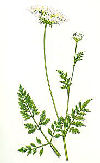 The stalks bear large tufts of white flowers with a deep purple flower in the middle of each. The root is small, hard and long and unfit to eat. They break wind and remove stitches in the side, provoke urine and women's courses and help to break and expel the stone. The seed is good for the dropsy and for those whose bellies are swollen with wind. It helps the colic, the stone in the kidneys and rising of the mother. Taken in wine, or boiled in wine and taken, the seeds help conception. Applied with honey, the leaves cleanse running sores or ulcers. The Wild Carrot is rich in vitamins and carotene, from which the body manufactures vitamin A. The infusion of the herb is used as a treatment for fluid retention. The powdered seeds made into a tea - one teaspoonful to a cup - are taken to relieve colic. The dried flowers are also used as a tea as a remedy for dropsy.
The stalks bear large tufts of white flowers with a deep purple flower in the middle of each. The root is small, hard and long and unfit to eat. They break wind and remove stitches in the side, provoke urine and women's courses and help to break and expel the stone. The seed is good for the dropsy and for those whose bellies are swollen with wind. It helps the colic, the stone in the kidneys and rising of the mother. Taken in wine, or boiled in wine and taken, the seeds help conception. Applied with honey, the leaves cleanse running sores or ulcers. The Wild Carrot is rich in vitamins and carotene, from which the body manufactures vitamin A. The infusion of the herb is used as a treatment for fluid retention. The powdered seeds made into a tea - one teaspoonful to a cup - are taken to relieve colic. The dried flowers are also used as a tea as a remedy for dropsy.
Medicinal Uses in Brief:
Diuretic; remedy for dropsy; aid in conception; remedy for colic; remedy for intestinal gas.
"A great amount of farming, or perhaps one should speak of gardening, is done at the oasis, but little of this is exported.
At the oasis will be grown a hybrid, brownish Sa-Tarna, adapted to the heat of the desert; most Sa-Tarna is yellow; and beans, berries, onions, tuber suls, various sorts of melons, a foliated leaf vegetable, called Katch, and various root vegetables, such as turnips, carrots, radishes, of the sphere and cylinder varieties, and korts, a large, brownish-skinned, thick-skinned, sphere-shaped vegetable, usually some six inches in width, the interior of which is yellowish, fibrous and heavily seeded. At the oasis, because of the warm climate, the farmers can grow two or more crops a year." — Tribesmen of Gor, page 37.
• Cherries
Delicate tree which bears tiny delicious red fruit grown in the city of Tyros.
The leaves are cooling and may be used in inflammations. The berries draw down the urine when it has grown hot, sharp and painful in the passage. 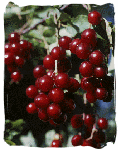 It is good to expel the stone and gravel and to cleanse ulcers in the bladder. Take three or four good handfuls of the berries, fresh or dried, bruise them and put them into beer or ale when it is new and tunned up. Taken daily this drink has been found to ease the pains and expel the stone. A decoction of the berries in wine and water is the most usual way to take them, but the powder of berries taken in a drink is more effectual. Not used by modern herbalists, but homeopaths make a tincture from the ripe berries. These are diuretic, laxative, and cooling in fevers. Overdoses cause constipation. The usual dose is about five or six berries.
It is good to expel the stone and gravel and to cleanse ulcers in the bladder. Take three or four good handfuls of the berries, fresh or dried, bruise them and put them into beer or ale when it is new and tunned up. Taken daily this drink has been found to ease the pains and expel the stone. A decoction of the berries in wine and water is the most usual way to take them, but the powder of berries taken in a drink is more effectual. Not used by modern herbalists, but homeopaths make a tincture from the ripe berries. These are diuretic, laxative, and cooling in fevers. Overdoses cause constipation. The usual dose is about five or six berries.
Medicinal Uses in Brief:
The leaves are used to soothe inflamations; laxative, diuretic, cooling fevers. The fruit is helpful in alleviating arthritis and gout, as well as urinary and kidney infections.
"It reminds me of the cherries of Tyros," I said. — Beasts of Gor, page 349.
• Cinnamon Bark / Cinnamon
A tree which produces a fruit, generally ground into a sweet spice which is a main export of the Schendi region; also has medicinal value.
Add cinnamon to remedies for acute symptoms, as this herb is a stimulant to other herbs and to the body, enabling herbal remedies to work faster. 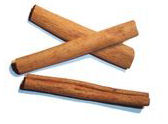 It is also a blood purifier, an infection preventer, and a digestive aid. It has been used to treat menstrual cramps and diarrhea. Do not ingest cinnamon oil. The essential oil is used in aromatherapy to treat nausea, tiredness, and depression, and is used in massage oils to treat rheumatism.
It is also a blood purifier, an infection preventer, and a digestive aid. It has been used to treat menstrual cramps and diarrhea. Do not ingest cinnamon oil. The essential oil is used in aromatherapy to treat nausea, tiredness, and depression, and is used in massage oils to treat rheumatism.
Medicinal Uses in Brief:
A stimulant which enables other herbal remedies to work faster; blood purifier; antibiotic properties; digestion aid; menstrual cramps; diarrhea treatment .
"Yes," I said. "It is cinnamon and cloves, is it not?"
"Yes," said Ulafi, "and other spices, as well." — Explorers of Gor, page 98.
• Cinnamon Tree
The tree upon which the prized cinnamon and cinnamon bark is extracted.
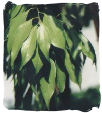
Etymology: Middle English cynamone, cynamum, from Middle French & Latin; Middle French cinnamome, from Latin cinnamomum, cinnamon, cinnamum, from Greek kinnamomon, kinnamon, of non-Indo-European origin; akin to Hebrew qinnamon cinnamon;
"1a : the highly aromatic bark of any of several trees of the genus Cinnamomum yielding cinnamaldehyde and other aromatic products in the form of cinnamon oil;
1b: a culinary spice prepared from cinnamon either by powdering or by drying in small rolls;
2: a tree that yields cinnamon." — Merriam-Webster Dictionary ©2004-2006
• Clover
Low growing, three-leafed plant; being as there are no leprechauns on the four-leaf variety is nothing of importance. 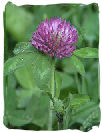 Red Clover is used as a nerve tonic and as a sedative for exhaustion. It is used to strengthen children with weak systems, and is used to treat children for coughs, bronchitis, and wheezing, as it is mild to their systems. It is also used for skin eruptions (such as acne).
Red Clover is used as a nerve tonic and as a sedative for exhaustion. It is used to strengthen children with weak systems, and is used to treat children for coughs, bronchitis, and wheezing, as it is mild to their systems. It is also used for skin eruptions (such as acne).
Medicinal Uses in Brief:
Nerve tonic, sedative; treatment for coughs, bronchitis and wheezing; treatment of skin eruptions.
Etymology: Middle English; Date: before 12th century;
"Any of a genus (Trifolium) of low leguminous herbs having trifoliolate leaves and flowers in dense heads and including many that are valuable for forage and attractive to bees." — Merriam-Webster Dictionary ©2004-2006"Any member of a genus (Lespedeza) of herbaceous plants in the pea family (Fabaceae), some of which are useful as forage and green manure crops. The approximately 40 species in the genus are native to North America, tropical and East Asia, and Australia. The lespedezas may be roughly grouped as herbaceous perennials, small shrubs, and annuals." — Encyclopaedia Britannica ©2004-2006
"I set her down on a bed of green clover. Beyond it, some hundred yards away, I could see the border of a yellow field of Sa-Tarna and a yellow thicket of Ka-la-na trees." — Tarnsman of Gor, page 96.
• Cloves
One of the main trading goods of the Schendi.
The fruit (cloves) are a great spice for cooking with, as well as medicinal values. 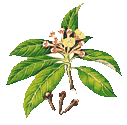 Clove oil will stop a toothache when applied directly to the cavity. It is very warm and stimulating to the system, and is very useful with people who have cold extremities. Cloves will promote sweating with fevers, colds, and flu. It is often used in remedies for whooping cough. Cloves are also safe and effective for relieving vomiting during pregnancy. Stick cloves into the skin of a whole lemon, covering it completely, and hang the lemon in closets or place in drawers to drive away insects. The essential oil is used in aromatherapy to treat infections, cold, and flu.
Clove oil will stop a toothache when applied directly to the cavity. It is very warm and stimulating to the system, and is very useful with people who have cold extremities. Cloves will promote sweating with fevers, colds, and flu. It is often used in remedies for whooping cough. Cloves are also safe and effective for relieving vomiting during pregnancy. Stick cloves into the skin of a whole lemon, covering it completely, and hang the lemon in closets or place in drawers to drive away insects. The essential oil is used in aromatherapy to treat infections, cold, and flu.
Medicinal Uses in Brief:
The oil can be used to ease toothaches; poultice to treat those with cold extremities; promote sweating with fevers, cold and flu; remedy for whooping cough; relieving vomiting during pregnancy.
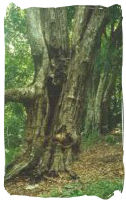
Etymology: alteration (probably influenced by 1clove) of Middle English clowe, cloue, from Old French clou (de girofle), literally, nail of clove, from Latin clavus nail;
"1a : the pungent fragrant aromatic reddish brown dried flower bud of a tropical tree; b: a spice consisting of whole or ground cloves;
2: a moderate-sized very symmetrical red-flowered tropical evergreen tree (Eugenia caryophyllata or Syzygium aromaticum) of the family Myrtaceae that is probably native to the Moluccas but is now widely cultivated in the tropics (as Zanzibar and Madagascar) for its flower buds which are the source of cloves." — Merriam-Webster Dictionary ©2004-2006
"Yes," I said. "It is cinnamon and cloves, is it not?"
"Yes," said Ulafi, "and other spices, as well." — Explorers of Gor, page 98.
• Festal
A type of shrub. No specific information is given on this shrub. It is, perhaps, the festal found on Earth.
On Earth, festal is an herb native to southern Russia and into such Middle Eastern areas as Lebanon and Israel. The history of the festal plant dates to ancient times, and has played a key herb in religious festivals (festals) and ceremonies, such as Passover; sometimes known as "willow herb" though not related to the willow.
Medicinal Uses in Brief:
Festal is used medicinally for such purposes as indigestion, dyspepsia, liver diseases, inflammatory diseases of stomach or bowels. Side effects include allergic reactions, diarrhea, nausea, abdominal pains, increased uric acid in the blood. In cases of over dosage the level of uric acid content in the blood plasma and urine will increase.
From the poem, "The Sabbath"
"Glorious Sabbath! Festal day!
Blessings bright around me play—
Crown my head, caress my feet,
Gifts of Heaven, my soul thus greet,
Through my placid hours so sweet!
Seems more festal herb and flower—
Glows parterre—more beauteous bower;
Seems now flowered mead more fair;
More perfumed the balmy air; …"
"What sort of shrubbery?" I asked.
"Some festal," he said, "some tes, a bit of tor." — Vagabonds of Gor, page 339.
• Garlic
Great for Warriors' blood pressure.
Genus name: Allium sativum The bulb of a member of the lily family, it is unknown from the wild. Garlic has actually evolved under cultivation during the past 5,000 years. Garlic has been used as food and medicine since the age of the Egyptian pharaohs.  The Greek historian and traveler Herodotus (484-425 B.C.) wrote that inscriptions on an Egyptian pyramid recorded the quantities of garlic consumed by the laborers. The Roman naturalist Pliny the Elder (A.D. 23-79) declared, "Garlic has powerful properties, and is of great benefit against changes of water and of residence." He recommended it to treat asthma, suppress coughs, and expel intestinal parasites, but noted some drawbacks (other than garlic breath): garlic dulled the sight, caused flatulence, injured the stomach if taken in excess, and caused thirst. In China, garlic was traditionally used for fevers, dysentery and intestinal parasites. When garlic is cut or crushed, it produces sulfur compounds, such as allicin, because a sulfarcontaining amino acid, alliin, comes into contact with the enzyme allinase. Garlic has an extremely complex chemistry, with more than 160 compounds identified from its bulbs and essential oil. Garlic is antiseptic and the juice diluted with water can be applied direct to wounds. It may also be used as a lotion or in an ointment. The plant contains a natural antibiotic substance and the oil obtained in capsule form is a popular method of taking it internally, although, of course, the bulb is widely used in cooking. It is taken to prevent colds. The juice made into a syrup is given for coughs, colds and asthma, because of its expectorant properties. Garlic is also diaphoretic and diuretic and helps to prevent the dropsy. The dose of the juice taken on its own is between to and 30 drops. The tincture of Garlic, available from herbalists, causes a drop in blood pressure, and is also effective against angina. It provokes urine and women's courses, helps the biting of mad dogs, and other venomous creatures; kills the worms in children, cuts and voids tough phlegm, purges the head, helps the lethargy, is a good preservative against, and a remedy for, any plague, sore or foul ulcer. It takes away spots and blemishes in the skin, ceases pains in the scars, and ripens and breaks imposthumes or other swellings. Garlic is also good in hydropic diseases, jaundice, falling-sickness, cramps, convulsions, piles or other cold diseases.
The Greek historian and traveler Herodotus (484-425 B.C.) wrote that inscriptions on an Egyptian pyramid recorded the quantities of garlic consumed by the laborers. The Roman naturalist Pliny the Elder (A.D. 23-79) declared, "Garlic has powerful properties, and is of great benefit against changes of water and of residence." He recommended it to treat asthma, suppress coughs, and expel intestinal parasites, but noted some drawbacks (other than garlic breath): garlic dulled the sight, caused flatulence, injured the stomach if taken in excess, and caused thirst. In China, garlic was traditionally used for fevers, dysentery and intestinal parasites. When garlic is cut or crushed, it produces sulfur compounds, such as allicin, because a sulfarcontaining amino acid, alliin, comes into contact with the enzyme allinase. Garlic has an extremely complex chemistry, with more than 160 compounds identified from its bulbs and essential oil. Garlic is antiseptic and the juice diluted with water can be applied direct to wounds. It may also be used as a lotion or in an ointment. The plant contains a natural antibiotic substance and the oil obtained in capsule form is a popular method of taking it internally, although, of course, the bulb is widely used in cooking. It is taken to prevent colds. The juice made into a syrup is given for coughs, colds and asthma, because of its expectorant properties. Garlic is also diaphoretic and diuretic and helps to prevent the dropsy. The dose of the juice taken on its own is between to and 30 drops. The tincture of Garlic, available from herbalists, causes a drop in blood pressure, and is also effective against angina. It provokes urine and women's courses, helps the biting of mad dogs, and other venomous creatures; kills the worms in children, cuts and voids tough phlegm, purges the head, helps the lethargy, is a good preservative against, and a remedy for, any plague, sore or foul ulcer. It takes away spots and blemishes in the skin, ceases pains in the scars, and ripens and breaks imposthumes or other swellings. Garlic is also good in hydropic diseases, jaundice, falling-sickness, cramps, convulsions, piles or other cold diseases.
Medicinal Uses in Brief:
Treatment for asthma, suppress coughs, dysentery; antiseptic (diluted with water can be applied to wounds); the oil can be made into lotions and ointments; 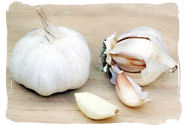 diaphoretic and diuretic; treatment of dropsy; lowers blood pressure; prevents angina; aids in lethargy; helps remove blemishes from the skin, ceases pain in scars; relieves menstral cramps and constipation.
diaphoretic and diuretic; treatment of dropsy; lowers blood pressure; prevents angina; aids in lethargy; helps remove blemishes from the skin, ceases pain in scars; relieves menstral cramps and constipation.
"I have peas and turnips, garlic and onions in my hut." — Outlaw of Gor, page 29.
• Gorean Peach
No mention is made in the books as to the nature of the plantlife which bears a yellow, fleshy fruit; most likely a tree. If the Gorean Peach is much like that of the peach of earth, then we can apply the following with concerns medically.
If the kernels be bruised and boiled in vinegar, until they become thick, and applied to the head, it marvellously makes the hair to grow upon bald places or where it is too thin.  Nothing is better than the leaves or flowers of this tree to purge cholera and the jaundice from children and young people. They are given as a syrup or as a conserve. The fruit provokes lust. The leaves bruised and laid on the belly kill worms; and boiled in ale and drank, they open the belly. The liquor that drops from the wounded tree is given with a decoction of Colt's Foot to those troubled with a cough or shortness of breath, adding thereto some sweet wine and Saffron. It is good for hoarseness, loss of voice and helps defects of the lungs, vomiting and spitting of blood. The leaves are laxative, sedative and expectorant. The leaves or powdered bark are excellent for inflammatory bowel disease and gastritis.. The same is also good for cystitis and tenderness of the bladder, because it stimulates the urine flow but is soothing. An oil expressed from the kernels is similar to Almond oil.
Nothing is better than the leaves or flowers of this tree to purge cholera and the jaundice from children and young people. They are given as a syrup or as a conserve. The fruit provokes lust. The leaves bruised and laid on the belly kill worms; and boiled in ale and drank, they open the belly. The liquor that drops from the wounded tree is given with a decoction of Colt's Foot to those troubled with a cough or shortness of breath, adding thereto some sweet wine and Saffron. It is good for hoarseness, loss of voice and helps defects of the lungs, vomiting and spitting of blood. The leaves are laxative, sedative and expectorant. The leaves or powdered bark are excellent for inflammatory bowel disease and gastritis.. The same is also good for cystitis and tenderness of the bladder, because it stimulates the urine flow but is soothing. An oil expressed from the kernels is similar to Almond oil.
Medicinal Uses in Brief:
Treatment of baldness; aphrodesiac properties; laxative, sedative and expectorant properties; treatment of inflammatory bowel disease and gastritis, cystitis and tenderness of bladder (stimulates urine flow).
"The fruit — grapes and peaches of some sort — was fresh and as cold as mountain snow." — Tarnsman of Gor, page 22.
"The girl lifted her head then and timidly lifted the ripe, rounded fruit which she held in her hands. Gorean peaches and plums, to me." — Rogue of Gor, pages 194.
• Gorean Pear
No mention is made in the books as to the nature of the plantlife which bears a yellow fruit. 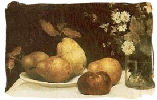 If the Gorean Pear is much like that of the pear of earth, then we can apply the following with concerns medically. The juice of the Pear is recommended by naturopaths for catarrh and colitis, hypertension, constipation and skin eruptions. It is rich in minerals and vitamins A, B and C.
If the Gorean Pear is much like that of the pear of earth, then we can apply the following with concerns medically. The juice of the Pear is recommended by naturopaths for catarrh and colitis, hypertension, constipation and skin eruptions. It is rich in minerals and vitamins A, B and C.
Medicinal Uses in Brief:
Treatment of colitis, hypertension, constipation and skin eruptions.
"In her hand there was a half of a yellow Gorean pear, the remains of a half moon of verr cheese imbedded in it." — Explorers of Gor, page 62.
• Gorean Plum
No mention is made in the books as to the nature of the plantlife which bears a fruit by this name. If the Gorean Plum is much like that of the plum of earth, then we can apply the following with concerns medically.
Plum tree leaves boiled in wine are good to wash and gargle the mouth and throat.  Their virtues differ with the great diversity of kinds. Sweet Plums moisten the stomach and make the belly soluble, whereas those that are sour quench the thirst more but bind the belly. The dried fruit, under the name of Damask Prunes, loosens the belly, and stewed they procure the appetite, open the body and allay choler. The gum that exudes from the tree is good to break the stone. Boiled in vinegar with the leaves and applied to the skin it kills tetter and ringworm. As a gargle or wash the leaves dry the flux of rheum coming to the palate, gurns, or almonds of the ears. The dried leaves are laxative and diuretic and of help in lowering temperature in fevers. Dried plums, or prunes, are laxative, and are best eaten first thing in the morning. The ripe fruit is delicious and nourishing. The juice alone is laxative and a digestive tonic and is indicated for dyspepsia, piles, obesity and skin eruptions.
Their virtues differ with the great diversity of kinds. Sweet Plums moisten the stomach and make the belly soluble, whereas those that are sour quench the thirst more but bind the belly. The dried fruit, under the name of Damask Prunes, loosens the belly, and stewed they procure the appetite, open the body and allay choler. The gum that exudes from the tree is good to break the stone. Boiled in vinegar with the leaves and applied to the skin it kills tetter and ringworm. As a gargle or wash the leaves dry the flux of rheum coming to the palate, gurns, or almonds of the ears. The dried leaves are laxative and diuretic and of help in lowering temperature in fevers. Dried plums, or prunes, are laxative, and are best eaten first thing in the morning. The ripe fruit is delicious and nourishing. The juice alone is laxative and a digestive tonic and is indicated for dyspepsia, piles, obesity and skin eruptions.
Medicinal Uses in Brief:
Leaves boiled make an excellent mouthwash and gargle; leaves boiled treats ringworm and other fungal skin infections; laxative; treatment of dyspepsia, obesity and skin eruptions.
"From the garment, to the sand about her ankles, there fell several small Gorean plums…" — Hunters of Gor, page 92.
"I had nearly stepped into a basket of plums." — Tribesmen of Gor, page 45.
"The girl lifted her head then and timidly lifted the ripe, rounded fruit which she held in her hands. Gorean peaches and plums, to me." — Rogue of Gor, pages 194.
• Honey
That sweet product of bees. Honey has antibacterial properties well established for over a century, yet, in many cultures honey has been used as a medicine since ancient times. 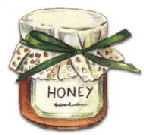 The effectiveness of honey in many of its medicinal uses is probably due to its antibacterial activity.
The effectiveness of honey in many of its medicinal uses is probably due to its antibacterial activity.
Medicinal Uses in Brief:
Antibacterial, antifungal properties.
"I saw small fruit trees, and hives, where honey bees were raised…" — Marauders of Gor, page 81.
• Kanda
Kanda is a desert shrub, and its leaves are chewed as a recreational drug, although its long term effects are usually deadly; an addiction that was highly frowned upon and considered an embaressment. Kanda, in its purest form, is highly lethal and often used in warfare. There is NO mention in the books whatsoever that kanda was used medicinally.
• Lichens
Lichens are mosslike plants which grow along rocks. 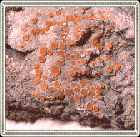 Lichen spreads itself along the ground by outgrowths of its fleshy thallus. The red spore producing structures are borne on the edges of the lobes.
Lichen spreads itself along the ground by outgrowths of its fleshy thallus. The red spore producing structures are borne on the edges of the lobes.
Lichens are a good herb for all diseases of the liver, to cool and cleanse it and to help inflammation and the yellow jaundice. It is a good remedy to stay the spreading of the tetters, ringworm and other fretting or running sores and scabs. An infusion of the whole plant was used as a laxative and for liver complaints in combination with other herbal remedies.
Medicinal Uses in Brief:
Laxative; used in treatment of liver complaints; antifungal.
Etymology: Latin, from Greek leich*n, lich*n, probably from leichein to lick;
"Any of numerous complex thallophytic plants that constitute the group Lichenes, that are made up of an alga and a fungus growing in symbiotic association on various solid surfaces (as rocks or the bark of trees), that consist of a branching thallus which is not differentiated into stem and leaves but which may be crustose, fruticose, or foliaceous and which contains algal gonidia embedded in a meshwork of fungal hyphae, and that include organisms important in the weathering and breakdown of rocks and some that are sources of foods or dyes; see Ascolichenes, Basidiolichenes; Iceland Moss, Reindeer Moss; Archil, Litmus." Encyclopedia of Herbs ©2004-2006
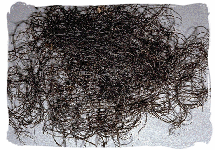 |
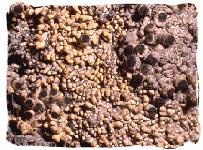 |
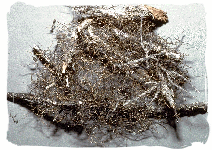 |
"There is often not enough food under any conditions, particularly I n northern Torvaldsland, and famine is not known. In such cases men feed on bark, and lichens and seaweed." — Marauders of Gor, page 55.
• Mint
It is not mentioned which form of garden variety mint plant (spearmint or peppermint) is found on Gor. 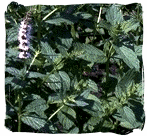 We do know that there has to be a mint plant as mint sticks were served as after dinner palate cleansers, as well as mint candies were often given to slave girls.
We do know that there has to be a mint plant as mint sticks were served as after dinner palate cleansers, as well as mint candies were often given to slave girls.
Spearmint is a valuable herb for stopping vomiting during pregnancy. It is gentle enough to use for colic in babies, while aiding in curing colds, flu, and gas. Peppermint is the leaf of a hybrid between spearmint (M. spicata) and watermint (M. aquatica). Peppermint is first mentioned in the medical literature of the early 1700s. Samuel Stern described it in 1801 in The American Herbal: "It is a stimulant. It restores the functions of the stomach, promotes digestion, stops vomiting, cures the hiccups, flatulent colic, hysterical depressions, and other like complaints." Peppermint leaf tea has been traditionally used for indigestion, nausea, colds, headache, and cramps, as well as antibacterial and antiviral, and it reduces muscle spasms. Two or three branches in the juice of four pomegranates stays the hiccough and vomiting. It is good to repress the milk in women's breasts. If the leaves be steeped or boiled in milk before being drunk, it is profitable to the stomach and restrains the milk from curdling. Applied to the forehead or temples, it eases pains in the head. The heads of young children can he washed with it to help against sores and scabs. The dried powder taken after meat helps digestion and those that are splenetic. Taken in wine, it helps women in childbearing. It is good against gravel and stone in the kidneys and the strangury. The decoction gargled in the mouth amends an ill-favored breath and cures the sore mouth and gums. Mint is a herb that is useful in all disorders of the stomach, including weakness, loss of appetite, pain and vomiting. .jpg) It also stops gonorrhea, fluor albus and immoderate flow of the menses. Peppermint oil should not be applied directly to mucous membranes, such as the nostrils, especially of infants and children.
It also stops gonorrhea, fluor albus and immoderate flow of the menses. Peppermint oil should not be applied directly to mucous membranes, such as the nostrils, especially of infants and children.
Medicinal Uses in Brief:
relief of colic and intestinal gas; promotes digestion; stops vomiting; antibacterial and antiviral properties; breath-enhancer; headache relief; used in the ease of childbirth; eases sore mouths and gums.
Warning: The oil should never be applied directly to mucuous membranes, such as nostrils.
"On the tray, too, was the metal vessel which had contained the black wine, steaming and bitter, from far Thentis, famed for its tarn flocks, the small yellow-enameled cups from which we had drunk the black wine, its spoons and sugars, a tiny bowl of mint sticks, and the softened, dampened cloths on which we had wiped our fingers." — Explorers of Gor, page 10.
• Mushrooms
Tasty fungus which grows on dung or putrefied earth, but is also cultivated in gardens.  The Mushroom is roasted and made into a poultice. It is used as an application to boils and abscesses and ripens them better than any preparation that can be made. The poultices are also of service against quinsies and inflammatory swellings.
The Mushroom is roasted and made into a poultice. It is used as an application to boils and abscesses and ripens them better than any preparation that can be made. The poultices are also of service against quinsies and inflammatory swellings.
Medicinal Uses in Brief:
Used as a poultice to treat boils, abcesses and other inflammatory swellings.
Warning: Some varieties are poisonous.
"I am an Alar," Hurtha explained. "Have a stuffed mushroom." — Mercenaries of Gor, page 81.
• Nutmeg
Tree which bears a fruit which is ground producing a sweet spice; also has medicinal value. 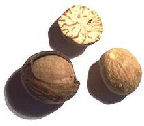 A small amount of Nutmeg, about the size of a pea, can be taken once daily over a long period (6 months to a year) to relieve chronic nervous problems, as well as heart problems stemming from poor circulation. Added to milk, baked fruits, and desserts, it aids in digestion, and relieves nausea. Large doses can be poisonous, and may cause miscarriage for pregnant women.
A small amount of Nutmeg, about the size of a pea, can be taken once daily over a long period (6 months to a year) to relieve chronic nervous problems, as well as heart problems stemming from poor circulation. Added to milk, baked fruits, and desserts, it aids in digestion, and relieves nausea. Large doses can be poisonous, and may cause miscarriage for pregnant women.
Medicinal Uses in Brief:
Nervous disorders; poor circulation; relieves nausea; aids in indigestion.
Warning: Large doses can cause miscarriage.
"I had had verr meat, cut in chunks and threaded on a metal rod, with slices of peppers and larma, and roasted; vulo stew with raisins, nuts, onions and honey; a Kort with melted cheese and nutmeg; hot Bazi tea, sugared, and, later, Turian wine." — Tribesmen of Gor, pages 47-48.
• Onion
Presumably the same as Earth onions.
Onion is used externally as an antiseptic. Internally, it can alleviate gas pains, reduce hypertension, and reduce cholesterol. Nursing mothers should use onion in small amounts, as the onion in breast milk can sometimes cause colic in sensitive babies.  Onions increase sperm. They kill worms in children if they drink the water in which the Onions have been steeped all night. Roasted Onions, eaten with honey or sugar and oil, help an inveterate cough and expectorate tough phlegm. Snuffed up the head, the juice purges the head and helps lethargy. The juice is good for scalds and burns, and used with vinegar it takes away blemishes, spots and marks in the skin. The properties of Onion are similar to Garlic. It is antiseptic, diuretic and expectorant. The juice is made into a syrup with honey and used as a medicine for coughs, asthma and bronchitis. Homoeopaths prescribe pills made from the Onion for hay fever and rhinitis. A tincture of onion made by steeping an Onion in alcohol is diuretic and used to expel sediment from the bladder and to treat dropsy.
Onions increase sperm. They kill worms in children if they drink the water in which the Onions have been steeped all night. Roasted Onions, eaten with honey or sugar and oil, help an inveterate cough and expectorate tough phlegm. Snuffed up the head, the juice purges the head and helps lethargy. The juice is good for scalds and burns, and used with vinegar it takes away blemishes, spots and marks in the skin. The properties of Onion are similar to Garlic. It is antiseptic, diuretic and expectorant. The juice is made into a syrup with honey and used as a medicine for coughs, asthma and bronchitis. Homoeopaths prescribe pills made from the Onion for hay fever and rhinitis. A tincture of onion made by steeping an Onion in alcohol is diuretic and used to expel sediment from the bladder and to treat dropsy.
Medicinal Uses in Brief:
Antiseptic properties; alleviate gas pains; reduce hypertension; reduce cholesterol; increase sperm; kill intestinal worms; expectorant; diuretic.
Warning: Nursing women should refrain from onion as it can taint the breast milk and cause colic.
"I have peas and turnips, garlic and onions in my hut." — Outlaw of Gor, page 29.
"I saw too, fields, fenced with rocks, in the sloping area. In them were growing, small at this season, shafts of Sa-Tarna; too, there would be peas, and beans, cabbages and onions, and patches of the golden sul, capable of surviving at this latitude." — Marauders of Gor, page 81.
"A great amount of farming, or perhaps one should speak of gardening, is done at the oasis, but little of this is exported. At the oasis will be grown a hybrid, brownish Sa-Tarna, adapted to the heat of the desert; most Sa-Tarna is yellow; and beans, berries, onions, tuber suls, various sorts of melons, a foliated leaf vegetable, called Katch, and various root vegetables, such as turnips, carrots, radishes, of the sphere and cylinder varieties, and korts, a large, brownish-skinned, thick-skinned, sphere-shaped vegetable, usually some six inches in width, the interior of which is yellowish, fibrous and heavily seeded. At the oasis, because of the warm climate, the farmers can grow two or more crops a year. Larma and tospits are also grown at the oases, in small orchards. Some rep is grown, for cloth, but most cloth comes to the oases from caravans." — Tribesmen of Gor, page 37.
• Pomegranate
Tree which produces hard shelled, red, fleshy, segmented fruits. 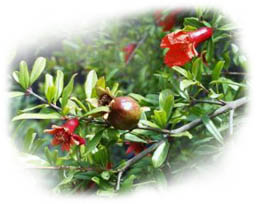 The fruit was known to the Romans, who named it either malum punicum with respect to their suspected origin, Carthage (punicus properly refers to Phoenicia in Asia Minor, but was in Latin more frequently used with respect to Carthage, a Phoenician colony in Northern Africa) or malum granatum; malum means apple and granatum derives from granum grain and means (multi)grained; so the fruit was named for its many seed grains. While the botanical genus name clearly was formed from the first of these two term, names of pomegranate in contemporary European tongues are adaptions or partial translations of the latter: German Granatapfel from Apfel apple and Italian melogranate still containing the Italian equivalent of Latin malum, apple. The English name has Latin pomum fruit, apple (French pomme apple) instead of malum.
The fruit was known to the Romans, who named it either malum punicum with respect to their suspected origin, Carthage (punicus properly refers to Phoenicia in Asia Minor, but was in Latin more frequently used with respect to Carthage, a Phoenician colony in Northern Africa) or malum granatum; malum means apple and granatum derives from granum grain and means (multi)grained; so the fruit was named for its many seed grains. While the botanical genus name clearly was formed from the first of these two term, names of pomegranate in contemporary European tongues are adaptions or partial translations of the latter: German Granatapfel from Apfel apple and Italian melogranate still containing the Italian equivalent of Latin malum, apple. The English name has Latin pomum fruit, apple (French pomme apple) instead of malum.
Traditionally in medicine, the root bark has a bitter taste and is used as antihelmintic and astringent. The rind of the fruit is used as an antiseptic in episodes of gingivitis, stomatitis, pyorrhea, tonsillitis and pharyngitis. The medicinal uses of pomegranate go back to ancient Egypt. It was also well-known in the traditional cultures of Persia and Pakistan. In addition, the Arabs had great appreciation for pomegranate. They introduced it to the south of Spain. The Spanish conquistadores introduced it widely in the colonies, where the indigenous people highly valued its many qualities and adopted it as part of their repertoire of medicinal plants.
A decoction of the bark is used for expelling tapeworm – 2 oz. (56 g) of the bark is steeped in 2 pt. (1.1 1) of water for 24 hours, then brought to the boil and simmered until 1 pt. (568 ml) is left. The bark of the root has similar properties. The dosage is 2 fl. oz. (56 ml), but it may cause nausea. The dose may need to be repeated and followed by an enema. 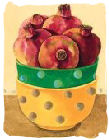 A decoction of the rind of the fruit cheeks diarrhoea and dysentery and, injected into the vagina, it cheeks leucorrhoea. It is also used as a gargle for sore throats. The juice of the fruit may also be used to expel worms from the bowel. It should be diluted in equal parts with water or with twice as much Carrot juice. It is also indicated in high blood pressure and arthritis.
A decoction of the rind of the fruit cheeks diarrhoea and dysentery and, injected into the vagina, it cheeks leucorrhoea. It is also used as a gargle for sore throats. The juice of the fruit may also be used to expel worms from the bowel. It should be diluted in equal parts with water or with twice as much Carrot juice. It is also indicated in high blood pressure and arthritis.
Medicinal Uses in Brief:
Anthelmintic, teniafuge, astringent, antidiarrheal, antidysenteric, and depurative; used in the treatment of gingivitis, stomatitis, pyorrhea, tonsillitis and pharyngitis.
Warning: Large doses may cause nausea, dizziness and vomiting.
Etymology: Middle English poumgrenet, from Middle French pomme grenate, literally, seedy apple; Date: 14th century;
"1: a thick-skinned several-celled reddish berry that is about the size of an orange and has many seeds with pulpy crimson arils of tart flavor;
2 : a widely cultivated tropical Old World tree (Punica granatum of the family Punicaceae) bearing pomegranates." — Merriam-Webster Dictionary ©2004-2006"The fruit of (Punica granatum,( a bush or small tree of Asia, which with a little-known species from the island of Socotra constitutes the family Punicaceae. The plant, which may attain 5 or 7 metres (16 or 23 feet) in height, has elliptic to lance-shaped, bright-green leaves about 75 millimetres (3 inches) long and handsome axillary orange-red flowers borne toward the ends of the branchlets. The calyx is tubular and persistent and has five to seven lobes; the petals are lance-shaped, inserted between the calyx lobes. The ovary is embedded in the calyx tube and contains several compartments in two series, one above the other. The fruit is the size of a large orange, obscurely six-sided, with a smooth, leathery skin that ranges from brownish yellow to red; within, it is divided into several chambers containing many thin, transparent vesicles of reddish, juicy pulp, each surrounding an angular, elongated seed. The fruit is eaten fresh, and the juice is the source of (grenadine syrup,( used in flavorings and liqueurs.
"Throughout the Orient, the pomegranate has since earliest times occupied a position of importance alongside the grape and the fig. According to the Bible, King Solomon possessed an orchard of pomegranates, and, when the children of Israel, wandering in the wilderness, sighed for the abandoned comforts of Egypt, the cooling pomegranates were remembered longingly. Centuries later, the prophet Muhammad remarked, "Eat the pomegranate, for it purges the system of envy and hatred." While the pomegranate is considered indigenous to Iran and neighbouring countries, its cultivation long ago encircled the Mediterranean and extended through the Arabian Peninsula, Afghanistan, and India. It is commonly cultivated in the Americas from the warmer parts of the United States to Chile. Though the pomegranate grows in a wide range of climates, good fruit is produced only where high temperatures and dry atmosphere accompany the ripening period." — Encyclopaedia Britannica ©2004-2006
"From outside I could smell date palms, pomegranates." — Tribesmen of Gor, page 115.
"Pomegranate orchards lie at the east of the oasis." I said. — Tribesmen of Gor, page 174.
• Pumpkin
A spherical gourd/vegetable grown in agricultural communities in the Barrens. 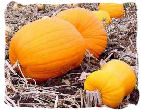 The seed is cooling and of the nature of the Melon. It is rarely used in medicine except in the making of emulsions. The seeds, bruised and liquidised in water, form an emulsion which is used to expel tapeworms. An infusion of the seeds is useful against catarrh (the common cold) and as a demulcent for the bowels and urinary tract when there is irritation. The seed contains anti-tumour properties, and is particularly suitable for the treatment of enlarged prostate. Please also refer to the Foods page for further information.
The seed is cooling and of the nature of the Melon. It is rarely used in medicine except in the making of emulsions. The seeds, bruised and liquidised in water, form an emulsion which is used to expel tapeworms. An infusion of the seeds is useful against catarrh (the common cold) and as a demulcent for the bowels and urinary tract when there is irritation. The seed contains anti-tumour properties, and is particularly suitable for the treatment of enlarged prostate. Please also refer to the Foods page for further information.
Medicinal Uses in Brief:
Used in the making of emulsions, for the treatment of such things as tapeworm, as wel as an expectorant (for treatment of the common cold).
Etymology: alteration (influenced by -kin) of pumpion, pompion, modification of Middle French popon, pompon pumpkin, melon, from Latin pepon-, pepo, from Greek pepon an edible gourd, from pepon cooked by sun, ripe, from peptein, pessein to cook, ripen, digest;
"Any of various usually firm-rinded fruits of vines of the genus Cucurbita that are widely cultivated as a vegetable, for pies, and for livestock feed; any of numerous usually large rounded and deep yellow to orange fruits produced by plants that are horticultural varieties of the natural species (C. pepo)." — Merriam-Webster Dictionary ©2004-2006
"They grow produce for their masters, such as wagmeza and wagmu, maize, or corn, and such things as pumpkins and squash." — Savages of Gor, page 234.
• Sedge
A plant found along rivers and marshes. Papyrus (rence) is a form of sedge. Sedge meadows are the result of flooding. They are most easily found in early spring. Areas that are low-lying and flat near rivers and streams will accumulate with a few inches of water. The rest of the year, sedge meadows rarely have standing water. Sedge meadows are most successful when the soil remains saturated most of the time. This allows for the abundant growth of a kind of grass called a sedge. The Egyptians used a special kind of sedge called papyrus to make paper. The soil in sedge meadow is formed from the decomposition of sedges like the Carex stricta. When a sedge grows it forms a symmetrical lump or hummock in the water. The soil between the tussocks of Carex stricta is peat that was created by the decay of the underground roots and stems of this plant. When peat dries out, it burns easily. As a matter of fact, peat is used in some countries as a form of fuel. Fires are a natural occurrence in a sedge meadow. In years of drought, fires will clean out the sedge meadow of invading woody plants.
Etymology: Middle English segge, from Old English secg; akin to Middle High German segge sedge, Old English sagu, sage saw;
1a: a plant of the family Cyperaceae and especially of the genus Carex; b: Sweet Flag; c: Yellow Iris." Encyclopedia of Herbs ©2004-2006
Various Members of the Sedge Family Cotton Grass (Eriophorum) Sedge (Carex vesicaria)
Common name for members of the Cyperaceae, a family of grasslike and rushlike herbs found in all parts of the world, especially in marshes of subarctic and temperate zones. The name sedge is also used specifically for species of the genus Carex of the same family. Sedges differ from true grasses in having solid, angular (usually triangular) stems. Most are perennial, reproducing by rhizomes. Some sedges are woven into mats and chair seats, and a few provide coarse hay. The pith of Cyperus papyrus was the source of the papyrus of ancient Egypt and other Mediterranean countries. Bulrushes, often called clubrushes, are sedges of the genus Scirpus; various other similar plants are also called bulrushes. The bulrushes in which the infant Moses was hidden (Ex. 2.8) were probably papyrus. The Oriental water chestnut ( Eleocharis tuberosa ) is cultivated extensively among the Chinese for its edible tubers. An unrelated Asian aquatic plant, Trapa natans, also called water chestnut (or water caltrop or hornnut) and sometimes also used for food, is now naturalized in the United States. Many genera of the sedge family have indigenous and abundant species in America. Sedge is classified in the division Magnoliophyta., class Liliopsida, order Cyperales, family Cyperaceae." — Columbia Encyclopedia, Sixth Edition, Copyright ©2004-2006.
Sweet Sedge:
Synonyms: Calamus. Sweet Flag. Sweet Root. Sweet Rush. Sweet Cane. Gladdon. Sweet Myrtle. Myrtle Grass. Myrtle Sedge. Cinnamon Sedge. 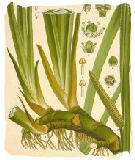 Part Used: Root.
Part Used: Root.
Habitat: Found in all European countries except Spain. Southern Russia, northern Asia Minor, southern Siberia, China, Japan, northern United States of America, Hungary, Burma, Ceylon and India.
The Sweet Sedge is a vigorous, reed-like, aquatic plant, flourishing in ditches, by the margins of lakes and streams and in marshy places generally, associated with reeds, bullrushes and bur-reed. Its erect, sword-shaped leaves bear considerable resemblance to those of the Yellow Flag, hence its equally common popular name of 'Sweet Flag,' though it is not related botanically to the Iris, being a member of the Arum order, Araceae. All parts of the plant have a peculiar, agreeable fragrance. Formerly, on account of its pleasant odour, it was freely strewn on the floors of churches at festivals and often in private houses, instead of rushes. The specific name, calamus, is derived from the Greek calamos (a reed). The floors of Norwich Cathedral until quite recently were always strewn with calamus at great festivals. The rhizomes are gathered when large enough, generally after two or three years, and before they lose their firmness and become hollow. Late autumn or early spring is the time chosen for collection. If actually growing in water, the raft-like masses of interwoven roots and mud, which in a river or lake float about a foot below the surface of the water, are cut out in square sections, raked to the lake edge, the leaves stripped off and separated. Whether growing thus actually in water, or in moist ground, the rhizomes are next thoroughly washed in a trough, and then, deprived of the far less aromatic and brittle rootlets, which are 4 to 6 inches long, unbranched, but near the tip beset with soft, thin fibres. The fresh root-stock is brownish-red, or greenish-white and reddish within and of a spongy texture, tolerably uniform in transverse section. It has an aromatic sweet odor and a bitterish, pungent taste.
Various Members of the Sedge Family Umbrella Plant (Cyperus alternifolius) Bulrush (Scirpus palustris)
Other Sedges:
The Sedge family is of comparatively slight economic importance. The plants are distinguished from the true Grasses, which they closely resemble, by their solid stems, leafsheaths which are not connate, and the presence of but a single scale to each flower. They are mostly coarse, harsh and indigestible, and not adapted for food purposes, though the rhizomes of several have been utilized as starchy foods. Quite a number possess volatile oils and aromatic principles, while others are rich in astringents — chiefly the species indigenous to India and China.
Among the more important aromatics and carminatives are Cyperus sanguinea-fuscus (Nees), the Cure-pire of Paraguay, C. elegans (Rottb.) of Mexico; C. pertenuis(Roxb.), the Indian Nagar-motha or Koriak, whose roots, when dried and powdered, are used by the Indian ladies for perfuming their hair; and C. tegetum (Roxb.); Adrue or Guinea Rush is the rhizome of C. articulatus (Linn.), which, besides being used as a carminative, has a high repute in the East Indies for anti-emetic properties. The blackish tubers have a somewhat bitter, aromatic taste, resembling that of Lavender. A fluid extract is prepared from them used in herbal medicine. The aromatic properties of the drug cause a feeling of warmth to be diffused throughout the system and act as a sedative in dyspeptic disorders. It is common also in Jamaica and on the banks of the Nile.
C. Papyrus is the Egyptian Papyrus, the fibrous stems of which provided the earliest form of paper known. This plant had various economic uses, as Pliny and other writers have shown, though as the Egyptians cultivated other Sedges, it is probable that these became more exclusively used for food and fuel, sails and cordage, baskets and sieves, not to speak of punts or canoes to which the prophet Isaiah refers (Isaiah xviii. 2), where the Ethiopians are spoken of as sending ambassadors by the sea even in vessels of bulrushes upon the waters (the Hebrew word is gome). The papyrus was, in ancient times, carefully cultivated, especially in certain districts of Lower, and probably of Upper Egypt also, for the great and important purpose with which its name must ever be associated.
Non Medical Uses:
Calamus Oil is used in perfumery — an alcoholate is made with 3 kilos to 3.5 kilos of rhizome to 20 litres of 85 per cent alcohol. The oil is strong and fragrant, its taste warm, bitterish, pungent and aromatic. Its active principles are taken up by boiling water. It is a thick, pale yellow liquid. Little is known of its chemistry, though it possibly contains pinene and the chief aromatic constituent is asaryl aldehyde. The powdered root is also esteemed in Ceylon and India as a vermifuge and an insecticide, especially in relation to fleas. Sprinkled round a tree attacked by white ants in Malay (Perak) it was found to destroy those that were near the surface and prevented others from attacking the tree. In powder, Calamus root on account of its spicy flavor serves as a substitute for cinnamon, nutmeg and ginger. It is said also to be used by snuff manufacturers and to scent hair-powders and in tooth-powders, in the same way as orris. The oil is used by rectifiers to improve the flavor of gin and to give a peculiar taste and fragrance to certain varieties of beer. In the United States, Calamus was also formerly used by country people as an ingredient in making wine bitters.
Medical Uses:
Calamus was formerly much esteemed as an aromatic stimulant and mild tonic. A fluid extract is an official preparation in the United States and some other Pharmacopceias, but it is not now official in the British Pharmacopceia, though it is much used in herbal medicine as an aromatic bitter. On account of the volatile oil which is present, it also acts as a carminative, removing the discomfort caused by flatulence and checking the growth of the bacteria which give rise to it. It is used to increase the appetite and benefit digestion, given as fluid extract, infusion or tincture. Tincture of Calamus, obtained by macerating the finely-cut rhizome in alcohol for seven days and filtering, is used as a stomachic and flavoring agent. It has a brownish-yellow color and a pungent, spicy taste. The essential oil is used as an addition to inhalations. The dried root may be chewed ad libitum to relieve dyspepsia or an infusion of 1 OZ. to 1 pint of boiling water may be taken freely in doses of a teacupful. The dried root is also chewed to clear the voice. Calamus has been found useful in ague and low fever, and was once greatly used by country people in Norfolk, either in infusion, or powdered, as a remedy against the fever prevalent in the Fens. Its use has been attended with great success where Peruvian bark has failed. It is also beneficial as a mild stimulant in typhoid cases." — from www.botanical.com
Medicinal Uses in Brief:
Treatment of dyspepsia, laryngitis, pharyngitis, tonsillitis, ague, fever; stimulant and anti-emetic properties.
"It was late in the afternoon, the fourteenth Gorean Ahn I would have guessed. Some swarms of insects hung in the sedge here and there but I had not been much bothered: it was late in the year, and most of the Gorean insects likely to make life miserable for men bred in, and frequented, areas in which bodies of unmoving, fresh water were plentiful." — Raiders of Gor, page 5.
• Spikenard
A perennial; export from the Bazi region; an herb used in healing for salves.
Spikenard is a aromatic rhizome. 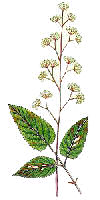 The botanical name has its roots in the Hindu word Jatamansi which means "lock of hair." It's use goes back in several cultures and religions. Medically it's part of the Ayurveda, and is traditionally considered to calm the nerves and promote awareness and strengthen the mind. It is in the same family as Valeriana jatamansi (Indian valerian) and was sometimes used treatment of hysteria. Spikenard is one of the most common ingredients in ancient Japanese incense recipes. One of the most famous references to Spikenard comes in the Christian New Testament, book of John, chapter 12:
The botanical name has its roots in the Hindu word Jatamansi which means "lock of hair." It's use goes back in several cultures and religions. Medically it's part of the Ayurveda, and is traditionally considered to calm the nerves and promote awareness and strengthen the mind. It is in the same family as Valeriana jatamansi (Indian valerian) and was sometimes used treatment of hysteria. Spikenard is one of the most common ingredients in ancient Japanese incense recipes. One of the most famous references to Spikenard comes in the Christian New Testament, book of John, chapter 12:
Then Jesus six days before the passover came to Bethany, where Lazarus was which had been dead, whom he raised from the dead.There they made him a supper; and Martha served: but Lazarus was one of them that sat at the table with him. Then took Mary a pound of ointment of spikenard, very costly, and anointed the feet of Jesus, and wiped his feet with her hair: and the house was filled with the odour of the ointment. Then saith one of his disciples, Judas Iscariot, Simon's son, which should betray him, "Why was not this ointment sold for three hundred pence, and given to the poor?" This he said, not that he cared for the poor; but because he was a thief, and had the bag, and bare what was put therein. Then said Jesus, "Let her alone: against the day of my burying hath she kept this. For the poor always ye have with you; but me ye have not always."
Synonyms:
Spignet. Life of Man. Pettymorell. Old Man's Root. Indian Spikenard. Indian Root.
Part Used: Root.
The much-branched stem grows from 3 to 6 feet high. Very large leaves, consisting of thin oval heart-shaped, double saw-toothed leaflets. Small greenish flowers in many clusters - blooming later than Aralia medicaulis (for which it is often substituted), July to August. Has roundish red-brown berries going dark purple. Root-stock thick and large, spicy and aromatic. Fracture of cortex short, of the wood also short and fibrous. Odour aromatic, taste mucilaginous, pungent and slightly acrid. Transverse section of root shows thick bark, several zones containing oil. The plant grows freely in the author's garden.
Constituents:
Volatile oil, resin, tannin, etc.
Medicinal Action and Uses:
Stimulant, diaphoretic, alterative for syphilitic, cutaneous and rheumatic cases, and used in same manner and dosage as genuine Sarsaparilla. Much used also for pulmonary affections, and enters into the compound syrup of Spikenard. Fluid extract, 1/2 to 1 drachm. Infusion of 1/2 OZ. to a pint of water in wineglassful doses. — from:: Botanical.com
The powdered root is used to provoke urine and ease pains caused by stone in the reins and kidneys. The powder is drunk in cold water. It helps the jaundice and those who are liver-grown. It makes a good ingredient in mithridate and other antidotes against poison. Pregnant women are forbidden to take it inwardly. The oil is good for easing arthritic joints. It works powerfully on old cold griefs of the head and brain, stomach, liver, spleen, and bladder.It purges the brain of rheum, being snuffed up the nostrils. It comforts the brains and helps cold pains in the head and the shaking palsy. Two or three spoonfuls help passions of the heart, swoonings and the colic. The root is dried and powdered for use. The plant also contains an oil and a resin. It is used in much the same way as Sarsaparilla, previously described. An infusion is taken as a blood purifier in syphilitic, rheumatic and skin diseases. In making the infusion, use only 1/2 oz (14 g) of powder to 1 Pt (568 ml) of boiling water. A useful remedy for pectoral complaints, it can be made into a syrup and flavoured with Peppermint. It is particularly recommended for coughs and colds.
Medicinal Uses in Brief:
Stimulant, diaphoretic, alterative for syphilitic, cutaneous and rheumatic cases, and used in same manner and dosage as genuine Sarsaparilla. Much used also for pulmonary affections, and enters into the compound syrup of Spikenard.. Ointments are made of this herb for easing arthritic joints, as well as an inhalant to clear congestion.
Warning: May cause miscarriage in pregnant women if ingested.
Etymology: Middle English, from Middle French or Medieval Latin; Middle French spicanarde, from Medieval Latin spica nardi (translation of Greek nardou stachys), from Latin spica head (of grain), tuft (of a plant) + nardi, gen. of nardus nard;
"1a: a costly ointment with a musky odor valued as a perfume in ancient times — called also nard; b: an East Indian aromatic plant (Nardostachys jatamansi) of the family Valerianaceae from the dried roots and young stems of which the ointment spikenard is believed to have been derived
2a: an American herb (Aralia racemosa) distinguished from wild sarsaparilla by its more aromatic root and its panicled umbels — called also American spikenard; b: any of various other fragrant plants — usually used in combination, i.e., plowman's-spikenard." Encyclopedia of Herbs ©2004-2006Spikenard (Aralia racemosa) is a perennial that can reach 10 feet tall. It prefers rich humus soils, partial to full shade, and is commonly found wild in woods and thickets. Spikenard is used to shorten labor and to ease childbirth, reduces uric acid, and is often used in cough syrups. — Encyclopedia of Herbs ©2004-2006
"There is a little market in simple Laura for the more exquisite goods of Gor. Seldom will one find there Torian rolls of gold wire, interlocking cubes of silver from Tharna, rubies carved into tiny, burning panthers from Schendi, nutmegs and cloves, spikenard and peppers from the lands east of Bazi, the floral brocades, the perfumes of Tyros, the dark wines, the gorgeous diaphanous silks of glorious Ar. Life, even by Gorean standards, is primitive in the region of the Laurius, and northward, to the great forests, and along the coast, upward to Torvaldsland." — Captive of Gor, page 86.
• Tospit
A fruit of the Tospit Tree and Tospit Bush; very bitter. Most likely they are citrus in nature, containing large amounts of Vitamin C.
Medicinal Uses in Brief:
An excellent source of Vitamin C, they prevent nutritional deficiencies in seamen.
"The tospits, in the Forkbeard's orchard, which can grow at this latitude, as the larma cannot, were too green to eat. I smiled, ecalling that tospits almost invariably have an odd number of seeds, saving the rarer, long-stemmed variety. I do not care too much for tospits, as they are quite bitter. Some men like them. They are commonly used, sliced and sweetened with honey, and in syrups, and to flavor, with their juices, a variety of dishes. They are also excellent in the prevention of nutritional deficiencies at sea, in long voyages, containing, I expect, a great deal of vitamin C. They are sometimes called the seaman's larma. They are a fairly hardfleshed fruit, and are not difficult to dry and store. On the serpents they are carried in small barrels, usually kept, with vegetables, under the overturned keel of the longboat." — Marauders of Gor, page 102.
"On the way back to the hall, cutting through the tospit trees, we had passed by the sul patch." — Marauders of Gor, page 103.
"A great amount of farming, or perhaps one should speak of gardening, is done at the oasis, but little of this is exported… Larma and tospits are also grown at the oases, in small orchards." — Tribesmen of Gor, page 37.
"A boy passed, spitting out the seeds of a tospit. On the Plains of Turia, or in the Land of the Wagon People, it was available only late in the summer. Here, in Tor, however, with its two growing seasons, they might be available much earlier." — Tribesmen of Gor, pages 45-46.
Known Toxins
• Kanda
Kanda is a desert shrub, and its leaves are chewed as a recreational drug, although its long term effects are usually deadly; an addiction that was highly frowned upon and considered an embaressment. Kanda, in its purest form, is highly lethal and often used in warfare. There is NO mention in the books whatsoever that kanda was used medicinally.
On the twentieth day of the siege there was great rejoicing in the camp of Pa-Kur, because in one place the wires had been cut and a squad of spearmen had reached the main siege reservoir, emptying their barrels of toxic kanda, a lethal poison extracted from one of Gor"s desert shrubs. The city would now have to depend primarily on its private wells and the hope of rain. — Tarnsman of Gor, page 179.
Onlinisms of Healing Plants
Remember those many reasons how one obtained certain items from Earth? You know, the trips to Earth to get supplies, et al? The following plantlife are the most highly used things for various ailments across many chat sites on Gor in which the reasoning for having this item stems from those excuses. I mean, reasons.
Agrimony and Willow-Bark simply put, are two of the greatest onlinisms that plagues Gor. There is absolutly NO evidence that the Willow Tree or Agrimony is found on Gor! To see such practices in a roleplay room is rather an indulgence by those portraying such; it's obnoxiously annoying, especially for those who truly want realism in roleplay.
• Agrimony
Bust, first — what exactly is agrimony (in addition to being a word commonly misspelled by so-called healers and physicians)? I have my doubts as to whether or not the roleplayers who play healers of physicians actually know this.
Agrimony:
any plant of the genus Agrimonia, of the rose family (Rosaceae). The name particularly denotes A. eupatoria, an herbaceous, hardy perennial that is native to Europe but is widespread in other northern temperate regions, where it grows in hedge banks and the borders of fields. A. eupatoria grows to about 120 cm (4 feet) tall and has alternate feather-formed leaves that yield a yellow dye. The oval leaflets, about 2–6 cm (0.8–2.4 inches) long, have toothed margins. The small, stalkless yellow flowers are borne in a long terminal spike. The fruit is a bur about 0.6 cm in diameter and bears a number of hooks that enable it to cling easily to clothing or the coat of an animal. A. gryposepala, a similar species, is widespread in the United States. — Encyclopaedia Brittanica © 2006.
Roses? On Gor? Well, not actually roses, but of the same family. Hmm. Okay, let's explore this.
Synonyms: Common Agrimony. Church Steeples. Cockeburr. Sticklewort. Philanthropos
Part Used: The herb.
Habitat: The plant is found abundantly throughout England, on hedge-banks and the sides of fields, in dry thickets and on all waste places. In Scotland it is much more local and does not penetrate very far northward.
Agrimony has an old reputation as a popular, domestic medicinal herb, being a simple well known to all country-folk. It belongs to the Rose order of plants, and its slender spikes of yellow flowers, which are in bloom from June to early September, and the singularly beautiful form of its much-cut-into leaves, make it one of the most graceful of our smaller herbs.
Description:
From the long, black and somewhat woody perennial root, the erect cylindrical and slightly rough stem rises 1 or 2 feet, sometimes more, mostly unbranched, or very slightly branched in large specimens. The leaves are numerous and very rich in outline, those near the ground are often 7 or 8 inches long, while the upper ones are generally only about 3 inches in length. They are pinnate in form, i.e. divided up to the mid-rib into pairs of leaflets. The graduation in the size and richness of the leaves is noticeable: all are very similar in general character, but the upper leaves have far fewer leaflets than the lower, and such leaflets as there are, are less cut into segments and have altogether a simpler outline. The leaflets vary very considerably in size, as besides the six or eight large lateral leaflets and the terminal one, the mid-rib is fringed with several others that are very much smaller than these and ranged in the intervals between them. The main leaflets increase in size towards the apex of the leaf, where they are 1 to 1 1/2 inches long. They are oblong-oval in shape, toothed, downy above and more densely so beneath.
The flowers, though small, are numerous, arranged closely on slender, terminal spikes, which lengthen much when the blossoms have withered and the seed-vessels are maturing. At the base of each flower, which is placed stalkless on the long spike, is a small bract, cleft into three acute segments. The flowers, about 3/8 inch across, have five conspicuous and spreading petals, which are egg-shaped in form and somewhat narrow in proportion to their length, slightly notched at the end and of a bright yellow colour. The stamens are five to twelve in number. The flowers face boldly outwards and upwards towards the light, but after they have withered, the calyx points downwards. It becomes rather woody, thickly covered at the end with a mass of small bristly hairs, that spread and develop into a burr-like form. Its sides are furrowed and nearly straight, about 1/5 inch long, and the mouth, about as wide, is surmounted by an enlarged ring armed with spines, of which the outer ones are shorter and spreading, and the inner ones longer and erect.
The whole plant is deep green and covered with soft hairs, and has a slightly aromatic scent; even the small root is sweet scented, especially in spring. The spikes of flowers emit a most refreshing and spicy odor like that of apricots. The leaves when dry retain most of their fragrant odour, as well as the flowers, and Agrimony was once much sought after as a substitute or addition to tea, adding a peculiar delicacy and aroma to its flavour. Agrimony is one of the plants from the dried leaves of which in some country districts is brewed what is called 'a spring drink,' or 'diet drink,' a compound made by the infusion of several herbs and drunk in spring time as a purifier of the blood. In France, where herbal teas or tisanes are more employed than here, it is stated that Agrimony tea, for its fragrancy, as well as for its virtues, is often drunk as a beverage at table.
The plant is subject to a considerable amount of variation, some specimens being far larger than others, much more clothed with hairs and with other minor differences. It has, therefore, by some botanists, been divided into two species, but the division is now scarcely maintained. The larger variety, having also a greater fragrance, was named Agrimonia odorata.
The long flower-spikes of Agrimony have caused the name of 'Church Steeples' to be given the plant in some parts of the country. It also bears the title of 'Cockeburr,' 'Sticklewort' or 'Stickwort,' because its seed-vessels cling by the hooked ends of their stiff hairs to any person or animal coming into contact with the plant. It was, Gerard informs us, at one time called Philanthropos, according to some old writers, on account of its beneficent and valuable properties, others saying that the name arose from the circumstance of the seeds clinging to the garments of passers-by, as if desirous of accompanying them, and Gerard inclines to this latter interpretation of the name.
The whole plant yields a yellow dye: when gathered in September, the color given is pale, much like that called nankeen; later in the year the dye is of a darker hue and will dye wool of a deep yellow. As it gives a good dye at all times and is a common plant, easily cultivated, it seems to deserve the notice of dyers.
History:
The name Agrimony is from Argemone, a word given by the Greeks to plants which were healing to the eyes, the name Eupatoria refers to Mithridates Eupator, a king who was a renowned concoctor of herbal remedies.
Agrimony was one of the most famous vulnerary herbs. The Anglo-Saxons, who called it Garclive, taught that it would heal wounds, snake bites, warts, etc. In the time of Chaucer, when we find its name appearing in the form of Egrimoyne, it was used with Mugwort and vinegar for 'a bad back' and 'alle woundes': and one of these old writers recommends it to be taken with a mixture of pounded frogs and human blood, as a remedy for all internal haemorrhages. It formed an ingredient of the famous arquebusade water as prepared against wounds inflicted by an arquebus, or hand-gun, and was mentioned by Philip de Comines, in his account of the battle of Morat in 1476. In France, the eau de arquebusade is still applied for sprains and bruises, being carefully made from many aromatic herbs. It was at one time included in the London Materia Medica as a vulnerary herb, but modern official medicine does not recognize its virtues, though it is still fully appreciated in herbal practice as a mild astringent and tonic, useful in coughs, diarrhoea and relaxed bowels. By pouring a pint of boiling water on a handful of the dried herb - stem, leaves and flowers - an excellent gargle may be made for a relaxed throat, and a teacupful of the same infusion is recommended, taken cold three or four times in the day for looseness in the bowels, also for passive losses of blood. It may be given either in infusion or decoction. Constituents:
Agrimony contains a particular volatile oil, which may be obtained from the plant by distillation and also a bitter principle. It yields in addition 5 per cent of tannin, so that its use in cottage medicine for gargles and as an astringent applicant to indolent ulcers and wounds is well justified. Owing to this presence of tannin, its use has been recommended in dressing leather. Medicinal Action and Uses:
Astringent tonic, diuretic. Agrimony has had a great reputation for curing jaundice and other liver complaints. Gerard believed in its efficacy. He says: 'A decoction of the leaves is good for them that have naughty livers': and he tells us also that Pliny called it a 'herb of princely authoritie.' Dioscorides stated that it was not only 'a remedy for them that have bad livers,' but also 'for such as are bitten with serpents.' Dr. Hill, who from 1751 to 1771 published several works on Herbal medicine, recommends 'an infusion of 6 oz. of the crown of the root in a quart of boiling water, sweetened with honey and half a pint drank three times a day,' as an effectual remedy for jaundice. It gives tone to the system and promotes assimilation of food. Agrimony is also considered a very useful agent in skin eruptions and diseases of the blood, pimples, blotches, etc. A strong decoction of the root and leaves, sweetened with honey or sugar, has been taken successfully to cure scrofulous sores, being administered two or three times a day, in doses of a wineglassful, persistently for several months. The same decoction is also often employed in rural districts as an application to ulcers. Preparation:
Fluid extract dose, 10 to 60 drops.
In North America, it is said to be used in fevers with great success, by the Indians and Canadians. In former days, it was sometimes given as a vermifuge, though that use; of it is obsolete. In the Middle Ages, it was said to have magic powers, if laid under a man's head inducing heavy sleep till removed, but no narcotic properties are ascribed to it.
Green (Universal Herbal, 1832) tells us that 'its root appears to possess the properties of Peruvian bark in a very considerable degree, without manifesting any of its inconvenient qualities, and if taken in pretty large doses, either in decoction or powder, seldom fails to cure the ague.'
Culpepper (1652) recommends it, in addition to the uses already enumerated, for gout, 'either used outwardly in an oil or ointment, or inwardly, in an electuary or syrup, or concreted juice.' He praises its use externally, stating how sores may be cured 'by bathing and fomenting them with a decoction of this plant,' and that it heals 'all inward wounds, bruises, hurts and other distempers.' He continues: 'The decoction of the herb, made with wine and drunk, is good against the biting and stinging of serpents… it also helpeth the colic, cleanseth the breath and relieves the cough. A draught of the decoction taken warm before the fit first relieves and in time removes the tertian and quartian ague.' It 'draweth forth thorns, splinters of wood, or any such thing in the flesh. It helpeth to strengthen members that are out of joint.'
There are several other plants, not actually related botanically to the Common Agrimony, that were given the same name by the older herbalists because of their similar properties. These are the Common Hemp Agrimony, Eupatorium Cannabinum (Linn.) called by Gerard the Common Dutch Agrimony, and by Salmon, in his English Herbal (1710), Eupatorium Aquaticum mas, the Water Agrimony- also the plant now called the Trifid Bur-Marigold, Bidens tripartita (Linn.), but by older herbalists named the Water Hemp, Bastard Hemp and Bastard Agrimony. The name Bastard Agrimony has also been given to a species of true Agrimony, Agrimonium Agrimonoides, a native of Italy, growing in moist woods and among bushes. — from www.botanical.com
Okay, so we learn that indeed agrimony is medicinal, but where is it mentioned on Gor? Could it be the dina of Gor?
• Dina A small, short-stemmed multi-petaled flower; indigenous to hillsides in the northern temperate zones. The dina resembles that of an Earth rose; sometimes called the "slave flower." It is often used as a design for slave brands.
"… the dina is a small, lovely, multiply petaled flower, short-stemmed, and blooming in a turf of green leaves, usually on the slopes of hills, in the northern temperate zones of Gor; in its budding, though in few other ways, it resembles a rose; it is an exotic, alien flower; it is also spoken of, in the north, where it grows most frequently, as the slave flower…" — Slave Girl of Gor, page 61.
OOPS! It only states that it resembles a rose, not that it is the rose of Earth and is, in fact, an alien flower
Okay boys and girls, repeat after me: "Hasta la vista baby!" to agrimony on Gor!
• Willow Bark
There has been debate on whether the Hogarthe Tree is the "white willow" thus bearing argument that "willow-bark" would be available on Gor. Members of the family Salicaceae include poplars such as aspen, balm-of-gilead, cottonwood, true poplar, quiverleaf and western balsam, as well as the willow tree. The true white willow (genus Salix Alba) is not the white poplar (genus Populus alba), although the trees are of the same familiy, Salicaceae. The Hogarthe Tree is described as being related to the poplars of Earth (please refer to the Plants page under "Hogarthe Tree"), but whether the Hogarthe is a white poplar, or another of the family Salicaceae would be dependent on if it would be of medicinal value. Some poplars do have beneficial medicinal properties, such as the balsam poplar (Balsamic, expectorant, stimulant properties) and the cottonwood which treats urinary tract infections, fevers, and diarrhea. The white poplar, (Genus Populus, Species alba), has no medicinal uses whatsoever, whereas the white willow has great medicinal value, such as in the treatment of fevers, infection and diarrhea.
Two different poplars are mentioned in the Scriptures, the white poplar and the Euphrates poplar. White poplar, Populus alba, is familar in North America because it is often planted as a rapidly growing shade tree. The younger portions of the stem are usually a bright white; leaves are covered with dense hairs beneath but the upper surface is dark green. In Israel, the white poplar is often common along rivers and is frequent along the Banias, one of the sources of the Jordan; it is also widely planted. The second poplar is the Euphrates poplar, Populus euphratica, which forms a conspicuous part of the vegetation of the lower Jordan River as well as the Aravah. In the sections of the Euphrates River I have examined in northern Syria, P. euphratica is the most common tree. It forms dense stands along the banks, likely clones formed from runners of a parent tree. The leaves are polymorphic, that is, different leaves on the same tree or even the same branch may have strikingly different shapes. The bark of this tree, unlike its close relative the white poplar, is not white nor do the leaves have a white undersurface. It can tolerate relatively high salinity. Common in many parts of the Middle East, it is assumed that the Euphrates poplar is intended in Psalm 137:1-3 where the captives hung their harps on the "willows" of Babylon. The commonly planted "weeping willow" was given its name, Salix babylonica, after this portion of scripture. However, it is apparently native to China and never grew in Bible lands. — Old Dominion University
Willow is the inner bark of several species of Salix, trees in the willow family including white willow (S. alba). Four other European species recognized as sources are crack willow (S. fragilis), purple willow (S. purpurea), violet willow (S. daphnoides), and bay willow (S. pentandra). All except bay willow are naturalized in North America. For more than 2,000 years, people of the northern hemisphere used willow bark as a wash for external ulcers and internally to reduce fevers and relieve aches, pains, rheumatism, arthritis, and headaches. The Houma used black willow root bark as a blood thinner; the Creek used the root tea to relieve inflammation in rheumatism and reduce fever. In American folk tradition, the bark was used to thin the blood and treat fever. The tea was also taken for dyspepsia. — American Herbal Products Association
I stared, tremblingly, at the lonely pair of trees. "The trees," I said. "The trees." They were Hogarthe trees, named for Hogarthe, one of the early explorers in the area of the Barrens. They are not uncommon in the vicinity of water in the Barrens, usually growing along the banks of small streams or muddy, sluggish rivers. Their shape is very reminiscent of poplar trees on Earth, to which, perhaps, in virtue of seeds brought to the Counter-Earth, they may be related. — Blood Brothers of Gor, page 300.
![]()
Special Note
Because of the differences in publishing the books, depending upon whether published in the U.S. or Europe, depending upon whether a first publishing or a Masquerade Books release, page numbers will often vary. All of my quotes are from original, first-printing U.S. publications (see The Books page for a listing of publishers and dates) with the exception of the following books:
- Tarnsman of Gor (2nd Printing, Balantine)
- Outlaw of Gor (11th Printing, Balantine)
- Priest-Kings of Gor (2nd Printing, Balantine)
- Assassin of Gor (10th Printing, Balantine)
- Raiders of Gor (15th Printing, Balantine)
- Captive of Gor (3rd Printing, Balantine)
Disclaimer
These pages are not written for any specific home, but rather as informational pages for those not able to get ahold of the books and read them yourself. Opinions and commentaries are strictly my own personal views, therefore, if you don't like what you are reading — then don't. The information in these pages is realistic to what is found within the books. Many sites have added information, assuming the existences of certain products and practices, such as willowbark and agrimony for healing, and travel to earth and back for the collection of goods. I've explored the books, the flora, the fauna, and the beasts, and have compiled from those mentioned, the probabilities of certain practices, and what vegetation mentioned in the books is suitable for healing purposes, as well as given practicalities to other sorts of roleplaying assumptions.
